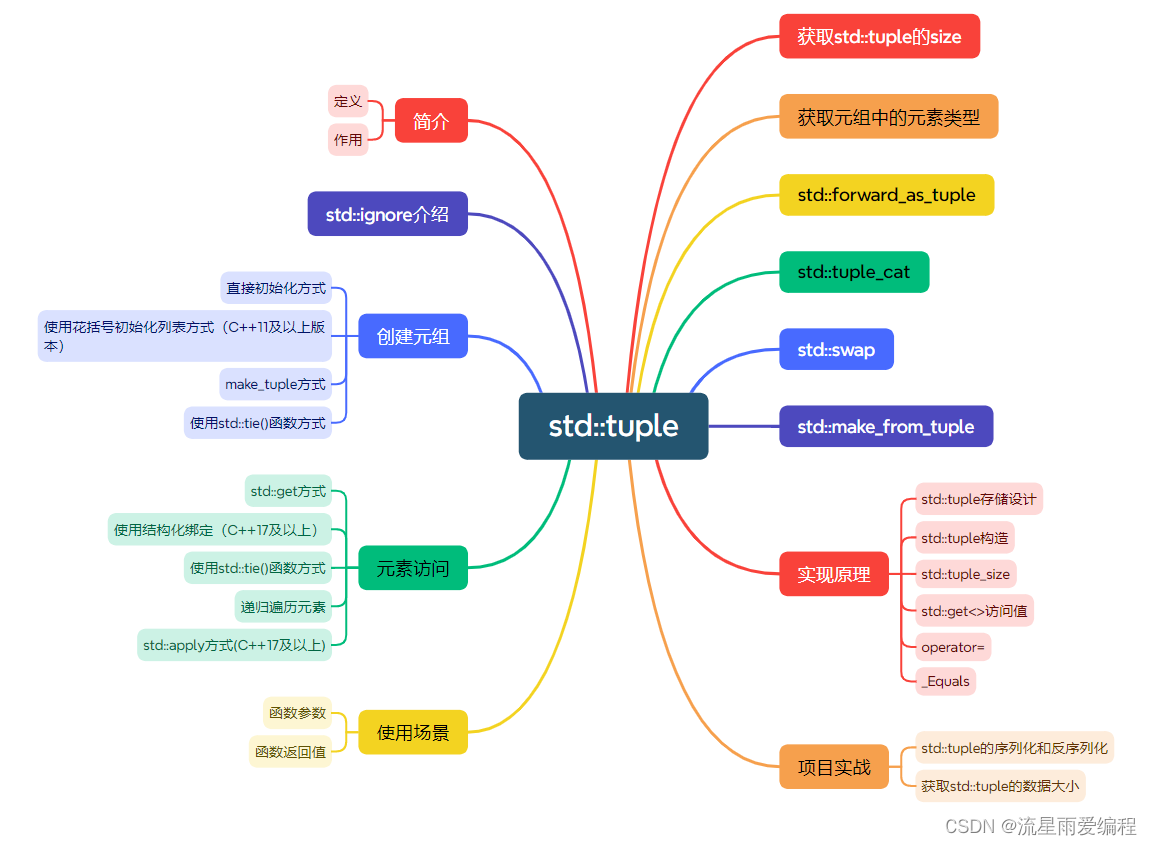
相关系列文章
C++之std::tuple(二) : 揭秘底层实现原理
C++三剑客之std::any(一) : 使用
C++之std::tuple(一) : 使用精讲(全)
C++三剑客之std::variant(一) : 使用
C++三剑客之std::variant(二):深入剖析
深入理解可变参数(va_list、std::initializer_list和可变参数模版)
std::apply源码分析
目录
1.std::tuple存储设计
2.std::tuple构造
3.std::tuple_size
4.std::get<>访问值
5.operator=
6._Equals
7.总结
之前的章节中讲解std::tuple的使用和一些注意事项,接下来我们就以vs2019的std::tuple的实现来讲解它的底层实现原理。
1.std::tuple存储设计
std::tuple存储的递归写法基于这样的思想:一个包含N(N>0)个元素的元组可以存储为一个元素(第1个元素,或者说是列表的头部)加上一个包含N-1个元素的元组(尾部),而包含0个元素的元组是单独的特殊情况。下面看一下示例:
std::tuple<bool, int, double, std::string> a(true, 1, 3.0, "1112222");因此,一个包含4个元素的元组a的递归构造如下:
1) 第一层递归。准备存储a的第一个元素true,剩下的是 std:tuple<int,double,std::string> 对象。
2) 第二层递归。准备存储a的第二个元素1,剩下的是 std::tuple<double,std::string> 对象。
3) 第三层递归。准备存储a第三个元素3.0, 剩下的是 std::tuple<std::string> 对象。
4) 第四层递归。准备存储a第四个元素"1112222",剩余的是std::tuple<>,遇到std::tuple<>递归结束。此时a的才开始存储元素,并且存储元素是从"1112222"开始,然后递归开始返回。
5) 返回到第3步的递归,存储duble类型的3.0。
6) 返回到第2步的递归,存储第int类型的1。
7) 返回到第1步的递归,存储第bool类型的true。
也就是说,std::tuple 的构造函数中,最后一个传入的元素最先构造,最先传入的元素最后一个构造,符合递归顺序,即入栈顺序。下面从源码角度,具体来看看 std::tuple 的实现。
template <class _This, class... _Rest>
class tuple<_This, _Rest...> : private tuple<_Rest...> { // recursive tuple definition
public:
using _This_type = _This; //当前元素
using _Mybase = tuple<_Rest...>; //余下的元素
//以下都是构造函数,罗列了部分
template <class _Tag, class _This2, class... _Rest2, enable_if_t<is_same_v<_Tag, _STD _Exact_args_t>, int> = 0>
constexpr tuple(_Tag, _This2&& _This_arg, _Rest2&&... _Rest_arg)
: _Mybase(_Exact_args_t{}, _STD forward<_Rest2>(_Rest_arg)...), _Myfirst(_STD forward<_This2>(_This_arg)) {}
template <class _Tag, class _Tpl, size_t... _Indices, enable_if_t<is_same_v<_Tag, _STD _Unpack_tuple_t>, int> = 0>
constexpr tuple(_Tag, _Tpl&& _Right, index_sequence<_Indices...>);
template <class _Tag, class _Tpl, enable_if_t<is_same_v<_Tag, _STD _Unpack_tuple_t>, int> = 0>
constexpr tuple(_Tag, _Tpl&& _Right)
: tuple(_Unpack_tuple_t{}, _STD forward<_Tpl>(_Right),
make_index_sequence<tuple_size_v<remove_reference_t<_Tpl>>>{}) {}
...
//获取余下的元素类,不带const
constexpr _Mybase& _Get_rest() noexcept { // get reference to rest of elements
return *this;
}
//获取余下的元素类,带const
constexpr const _Mybase& _Get_rest() const noexcept { // get const reference to rest of elements
return *this;
}
...
//
template <size_t _Index, class... _Types>
friend constexpr tuple_element_t<_Index, tuple<_Types...>>& get(tuple<_Types...>& _Tuple) noexcept;
template <size_t _Index, class... _Types>
friend constexpr const tuple_element_t<_Index, tuple<_Types...>>& get(const tuple<_Types...>& _Tuple) noexcept;
template <size_t _Index, class... _Types>
friend constexpr tuple_element_t<_Index, tuple<_Types...>>&& get(tuple<_Types...>&& _Tuple) noexcept;
template <size_t _Index, class... _Types>
friend constexpr const tuple_element_t<_Index, tuple<_Types...>>&& get(const tuple<_Types...>&& _Tuple) noexcept;
template <size_t _Index, class... _Types>
friend constexpr auto&& _Tuple_get(tuple<_Types...>&& _Tuple) noexcept;
template <class _Ty, class... _Types>
friend constexpr _Ty& get(tuple<_Types...>& _Tuple) noexcept;
template <class _Ty, class... _Types>
friend constexpr const _Ty& get(const tuple<_Types...>& _Tuple) noexcept;
template <class _Ty, class... _Types>
friend constexpr _Ty&& get(tuple<_Types...>&& _Tuple) noexcept;
template <class _Ty, class... _Types>
friend constexpr const _Ty&& get(const tuple<_Types...>&& _Tuple) noexcept;
//包装的当前的元素类,
_Tuple_val<_This> _Myfirst; // the stored element
};从上面的代码看到,std::tuple的递归继承用到了private继承,说明各个元素都是独立的,互相没有关系。std::tuple的元素之间是一种组合的关系。另外一个是private继承可以造成empty base最优化,这对致力于“对象尺寸最小化”的程序开发者而言,可能很重要。
那么,tuple是如何存储其中的元素呢?
_Tuple_val<_This> _Myfirst; // the stored element原来,它有个成员叫_Myfirst,它就是用来存储_This类型的变量的。你会看到_Myfirst的类型不是_This而是_Tuple_val<_This>,其实,_Tuple_val又是一个类模板,它的代码这里就不展开了,简而言之,它的作用是存储一个tuple中的变量。_Myfirst._Val才是真正的元素。从_Tuple_val的定义可以看出:
template <class _Ty>
struct _Tuple_val { // stores each value in a tuple
constexpr _Tuple_val() : _Val() {}
template <class _Other>
constexpr _Tuple_val(_Other&& _Arg) : _Val(_STD forward<_Other>(_Arg)) {}
template <class _Alloc, class... _Other, enable_if_t<!uses_allocator_v<_Ty, _Alloc>, int> = 0>
constexpr _Tuple_val(const _Alloc&, allocator_arg_t, _Other&&... _Arg) : _Val(_STD forward<_Other>(_Arg)...) {}
template <class _Alloc, class... _Other,
enable_if_t<conjunction_v<_STD uses_allocator<_Ty, _Alloc>,
_STD is_constructible<_Ty, _STD allocator_arg_t, const _Alloc&, _Other...>>,
int> = 0>
constexpr _Tuple_val(const _Alloc& _Al, allocator_arg_t, _Other&&... _Arg)
: _Val(allocator_arg, _Al, _STD forward<_Other>(_Arg)...) {}
template <class _Alloc, class... _Other,
enable_if_t<conjunction_v<_STD uses_allocator<_Ty, _Alloc>,
_STD negation<_STD is_constructible<_Ty, _STD allocator_arg_t, const _Alloc&, _Other...>>>,
int> = 0>
constexpr _Tuple_val(const _Alloc& _Al, allocator_arg_t, _Other&&... _Arg)
: _Val(_STD forward<_Other>(_Arg)..., _Al) {}
_Ty _Val;
};在std::tuple类中定义_Myfirst的权限是public的,所以对外面而言是直接访问元素值的。
通过上面的分析,a中定义的类和类的继承关系图如下所示:
class std::tuple<>;
class std::tuple<std::string>;
class std::tuple<double, std::string>;
class std::tuple<int, double, std::string>;
class std::tuple<bool, int, double, std::string>;
内存的分布图如下:

2.std::tuple构造
tuple的构造函数就是初始化_Myfirst和_MyBase,当然,_MyBase也要进行么一个过程,直到tuple<>。
//分类构造
template <class _Tag, class _This2, class... _Rest2, enable_if_t<is_same_v<_Tag, _STD _Exact_args_t>, int> = 0>
constexpr tuple(_Tag, _This2&& _This_arg, _Rest2&&... _Rest_arg)
: _Mybase(_Exact_args_t{}, _STD forward<_Rest2>(_Rest_arg)...), _Myfirst(_STD forward<_This2>(_This_arg)) {}
template <class _Tag, class _Tpl, size_t... _Indices, enable_if_t<is_same_v<_Tag, _STD _Unpack_tuple_t>, int> = 0>
constexpr tuple(_Tag, _Tpl&& _Right, index_sequence<_Indices...>);
template <class _Tag, class _Tpl, enable_if_t<is_same_v<_Tag, _STD _Unpack_tuple_t>, int> = 0>
constexpr tuple(_Tag, _Tpl&& _Right)
: tuple(_Unpack_tuple_t{}, _STD forward<_Tpl>(_Right),
make_index_sequence<tuple_size_v<remove_reference_t<_Tpl>>>{}) {}
template <class _Tag, class _Alloc, class _This2, class... _Rest2,
enable_if_t<is_same_v<_Tag, _STD _Alloc_exact_args_t>, int> = 0>
constexpr tuple(_Tag, const _Alloc& _Al, _This2&& _This_arg, _Rest2&&... _Rest_arg)
: _Mybase(_Alloc_exact_args_t{}, _Al, _STD forward<_Rest2>(_Rest_arg)...),
_Myfirst(_Al, allocator_arg, _STD forward<_This2>(_This_arg)) {}
template <class _Tag, class _Alloc, class _Tpl, size_t... _Indices,
enable_if_t<is_same_v<_Tag, _STD _Alloc_unpack_tuple_t>, int> = 0>
constexpr tuple(_Tag, const _Alloc& _Al, _Tpl&& _Right, index_sequence<_Indices...>);
template <class _Tag, class _Alloc, class _Tpl, enable_if_t<is_same_v<_Tag, _STD _Alloc_unpack_tuple_t>, int> = 0>
constexpr tuple(_Tag, const _Alloc& _Al, _Tpl&& _Right)
: tuple(_Alloc_unpack_tuple_t{}, _Al, _STD forward<_Tpl>(_Right),
make_index_sequence<tuple_size_v<remove_reference_t<_Tpl>>>{}) {}
//根据入口参数的不同分派到不同的构造函数
template <class _This2, class... _Rest2,
enable_if_t<conjunction_v<_STD _Tuple_perfect_val<tuple, _This2, _Rest2...>,
_STD _Tuple_constructible_val<tuple, _This2, _Rest2...>>,
int> = 0>
constexpr explicit(_Tuple_conditional_explicit_v<tuple, _This2, _Rest2...>) tuple(_This2&& _This_arg,
_Rest2&&... _Rest_arg) noexcept(_Tuple_nothrow_constructible_v<tuple, _This2, _Rest2...>) // strengthened
: tuple(_Exact_args_t{}, _STD forward<_This2>(_This_arg), _STD forward<_Rest2>(_Rest_arg)...) {}
tuple(const tuple&) = default;
tuple(tuple&&) = default;
tuple& operator=(const volatile tuple&) = delete;它还提供了默认拷贝构造函数和移动构造函数(移动语义是C++11中新增的特性,可以参考C++之std::move(移动语义)-CSDN博客)。其实,它还有很多构造函数,写起来挺热闹,无非就是用不同的方式为它赋初值,故省略。
上面的构造函数是根据_tag的不同被分派到不同的构造函数,它叫标签派发。源码中定义了如下的标签:
struct _Exact_args_t {
explicit _Exact_args_t() = default;
}; // tag type to disambiguate construction (from one arg per element)
struct _Unpack_tuple_t {
explicit _Unpack_tuple_t() = default;
}; // tag type to disambiguate construction (from unpacking a tuple/pair)
struct _Alloc_exact_args_t {
explicit _Alloc_exact_args_t() = default;
}; // tag type to disambiguate construction (from an allocator and one arg per element)
struct _Alloc_unpack_tuple_t {
explicit _Alloc_unpack_tuple_t() = default;
}; // tag type to disambiguate construction (from an allocator and unpacking a tuple/pair)3.std::tuple_size
先看一下源码:
template <class _Ty, _Ty _Val>
struct integral_constant {
static constexpr _Ty value = _Val;
using value_type = _Ty;
using type = integral_constant;
constexpr operator value_type() const noexcept {
return value;
}
_NODISCARD constexpr value_type operator()() const noexcept {
return value;
}
};
// TUPLE INTERFACE TO tuple
template <class... _Types>
struct tuple_size<tuple<_Types...>> : integral_constant<size_t, sizeof...(_Types)> {}; // size of tuple
template <class _Ty1, class _Ty2>
struct tuple_size<pair<_Ty1, _Ty2>> : integral_constant<size_t, 2> {}; // size of pairstd::integral_constant 包装特定类型的静态常量。它是 C++ 类型特征的基类。
std::tuple_size利用sizeof...求得可变参数的个数。
4.std::get<>访问值
先看一下tuple_element,tuple_element是获取tuple的元素,包括_Myfirst和_MyBase,源码:
//tuple<>
template <size_t _Index>
struct _MSVC_KNOWN_SEMANTICS tuple_element<_Index, tuple<>> { // enforce bounds checking
static_assert(_Always_false<integral_constant<size_t, _Index>>, "tuple index out of bounds");
};
//tuple的_index == 0
template <class _This, class... _Rest>
struct _MSVC_KNOWN_SEMANTICS tuple_element<0, tuple<_This, _Rest...>> { // select first element
using type = _This;
// MSVC assumes the meaning of _Ttype; remove or rename, but do not change semantics
using _Ttype = tuple<_This, _Rest...>;
};
//tuple的_index > 0
template <size_t _Index, class _This, class... _Rest>
struct _MSVC_KNOWN_SEMANTICS tuple_element<_Index, tuple<_This, _Rest...>>
: tuple_element<_Index - 1, tuple<_Rest...>> {}; // recursive tuple_element definition
//pair
template <size_t _Idx, class _Ty1, class _Ty2>
struct _MSVC_KNOWN_SEMANTICS tuple_element<_Idx, pair<_Ty1, _Ty2>> {
static_assert(_Idx < 2, "pair index out of bounds");
using type = conditional_t<_Idx == 0, _Ty1, _Ty2>;
};
template <size_t _Index, class _Tuple>
using tuple_element_t = typename tuple_element<_Index, _Tuple>::type;通过_Index获取tuple元素:
template <size_t _Index, class... _Types>
_NODISCARD constexpr tuple_element_t<_Index, tuple<_Types...>>& get(tuple<_Types...>& _Tuple) noexcept {
using _Ttype = typename tuple_element<_Index, tuple<_Types...>>::_Ttype;
return static_cast<_Ttype&>(_Tuple)._Myfirst._Val;
}
template <size_t _Index, class... _Types>
_NODISCARD constexpr const tuple_element_t<_Index, tuple<_Types...>>& get(const tuple<_Types...>& _Tuple) noexcept {
using _Ttype = typename tuple_element<_Index, tuple<_Types...>>::_Ttype;
return static_cast<const _Ttype&>(_Tuple)._Myfirst._Val;
}
template <size_t _Index, class... _Types>
_NODISCARD constexpr tuple_element_t<_Index, tuple<_Types...>>&& get(tuple<_Types...>&& _Tuple) noexcept {
using _Ty = tuple_element_t<_Index, tuple<_Types...>>;
using _Ttype = typename tuple_element<_Index, tuple<_Types...>>::_Ttype;
return static_cast<_Ty&&>(static_cast<_Ttype&>(_Tuple)._Myfirst._Val);
}
template <size_t _Index, class... _Types>
_NODISCARD constexpr const tuple_element_t<_Index, tuple<_Types...>>&& get(const tuple<_Types...>&& _Tuple) noexcept {
using _Ty = tuple_element_t<_Index, tuple<_Types...>>;
using _Ttype = typename tuple_element<_Index, tuple<_Types...>>::_Ttype;
return static_cast<const _Ty&&>(static_cast<const _Ttype&>(_Tuple)._Myfirst._Val);
}上述代码分析get<index>的流程:
1)通过_Index递归构造出类 tuple_element_t
2) 获取当前元素 _MyFirst.Val
通过_Ty获取tuple元素:
//辅助类
template <class _Ty, class _Tuple>
struct _Tuple_element {}; // backstop _Tuple_element definition
template <class _This, class... _Rest>
struct _Tuple_element<_This, tuple<_This, _Rest...>> { // select first element
static_assert(!_Is_any_of_v<_This, _Rest...>, "duplicate type T in get<T>(tuple)");
using _Ttype = tuple<_This, _Rest...>;
};
template <class _Ty, class _This, class... _Rest>
struct _Tuple_element<_Ty, tuple<_This, _Rest...>> { // recursive _Tuple_element definition
using _Ttype = typename _Tuple_element<_Ty, tuple<_Rest...>>::_Ttype;
};
//通过_Ty get
template <class _Ty, class... _Types>
_NODISCARD constexpr _Ty& get(tuple<_Types...>& _Tuple) noexcept {
using _Ttype = typename _Tuple_element<_Ty, tuple<_Types...>>::_Ttype;
return static_cast<_Ttype&>(_Tuple)._Myfirst._Val;
}
template <class _Ty, class... _Types>
_NODISCARD constexpr const _Ty& get(const tuple<_Types...>& _Tuple) noexcept {
using _Ttype = typename _Tuple_element<_Ty, tuple<_Types...>>::_Ttype;
return static_cast<const _Ttype&>(_Tuple)._Myfirst._Val;
}
template <class _Ty, class... _Types>
_NODISCARD constexpr _Ty&& get(tuple<_Types...>&& _Tuple) noexcept {
using _Ttype = typename _Tuple_element<_Ty, tuple<_Types...>>::_Ttype;
return static_cast<_Ty&&>(static_cast<_Ttype&>(_Tuple)._Myfirst._Val);
}
template <class _Ty, class... _Types>
_NODISCARD constexpr const _Ty&& get(const tuple<_Types...>&& _Tuple) noexcept {
using _Ttype = typename _Tuple_element<_Ty, tuple<_Types...>>::_Ttype;
return static_cast<const _Ty&&>(static_cast<const _Ttype&>(_Tuple)._Myfirst._Val);
}上述代码分析get<_Ty>的流程:
1)通过_Ty递归构造出类 _Tuple_element
2) 获取当前元素 _MyFirst.Val
5.operator=
tuple重载了赋值符号(=),这样,tuple之间是可以赋值的。
tuple& operator=(const volatile tuple&) = delete;
//以下是特殊情况是可以赋值的
template <class _Myself = tuple, class _This2 = _This,
enable_if_t<conjunction_v<_STD _Is_copy_assignable_no_precondition_check<_This2>,
_STD _Is_copy_assignable_no_precondition_check<_Rest>...>,
int> = 0>
_CONSTEXPR20 tuple& operator=(_Identity_t<const _Myself&> _Right) noexcept(
conjunction_v<is_nothrow_copy_assignable<_This2>, is_nothrow_copy_assignable<_Rest>...>) /* strengthened */ {
_Myfirst._Val = _Right._Myfirst._Val;
_Get_rest() = _Right._Get_rest();
return *this;
}
template <class _Myself = tuple, class _This2 = _This,
enable_if_t<conjunction_v<_STD _Is_move_assignable_no_precondition_check<_This2>,
_STD _Is_move_assignable_no_precondition_check<_Rest>...>,
int> = 0>
_CONSTEXPR20 tuple& operator=(_Identity_t<_Myself&&> _Right) noexcept(
conjunction_v<is_nothrow_move_assignable<_This2>, is_nothrow_move_assignable<_Rest>...>) {
_Myfirst._Val = _STD forward<_This>(_Right._Myfirst._Val);
_Get_rest() = _STD forward<_Mybase>(_Right._Get_rest());
return *this;
}
template <class... _Other, enable_if_t<conjunction_v<_STD negation<_STD is_same<tuple, _STD tuple<_Other...>>>,
_STD _Tuple_assignable_val<tuple, const _Other&...>>,
int> = 0>
_CONSTEXPR20 tuple& operator=(const tuple<_Other...>& _Right) noexcept(
_Tuple_nothrow_assignable_v<tuple, const _Other&...>) /* strengthened */ {
_Myfirst._Val = _Right._Myfirst._Val;
_Get_rest() = _Right._Get_rest();
return *this;
}
template <class... _Other, enable_if_t<conjunction_v<_STD negation<_STD is_same<tuple, _STD tuple<_Other...>>>,
_STD _Tuple_assignable_val<tuple, _Other...>>,
int> = 0>
_CONSTEXPR20 tuple& operator=(tuple<_Other...>&& _Right) noexcept(
_Tuple_nothrow_assignable_v<tuple, _Other...>) /* strengthened */ {
_Myfirst._Val = _STD forward<typename tuple<_Other...>::_This_type>(_Right._Myfirst._Val);
_Get_rest() = _STD forward<typename tuple<_Other...>::_Mybase>(_Right._Get_rest());
return *this;
}
template <class _First, class _Second,
enable_if_t<_Tuple_assignable_v<tuple, const _First&, const _Second&>, int> = 0>
_CONSTEXPR20 tuple& operator=(const pair<_First, _Second>& _Right) noexcept(
_Tuple_nothrow_assignable_v<tuple, const _First&, const _Second&>) /* strengthened */ {
_Myfirst._Val = _Right.first;
_Get_rest()._Myfirst._Val = _Right.second;
return *this;
}赋值符号返回左边的引用,这种行为和C++的内置类型是一致的。_Get_rest是tuple的成员函数,作用是把除了_Myfirst之外的那些元素拿出来。
6._Equals
//tuple内置函数
template <class... _Other>
constexpr bool _Equals(const tuple<_Other...>& _Right) const {
return _Myfirst._Val == _Right._Myfirst._Val && _Mybase::_Equals(_Right._Get_rest());
}
//重载operator==
template <class... _Types1, class... _Types2>
_NODISCARD constexpr bool operator==(const tuple<_Types1...>& _Left, const tuple<_Types2...>& _Right) {
static_assert(sizeof...(_Types1) == sizeof...(_Types2), "cannot compare tuples of different sizes");
return _Left._Equals(_Right);
}其中进行了静态断言,如果两个tuple的元素个数不相同,会引发一个编译时的错误。如果对应的类型不能用==进行比较,在模板特化时也会引发编译期的错误,例如,tuple<std::string, int>不能和tuple<int, char>比较,因为std::string和int是不能用==进行比较的。
7.总结
终于写完了,也是想了好久才写的,涉及到的知识点主要是模版推导。写的不好的地方,欢迎批评指正;如果觉得好,点个赞,收藏关注!

